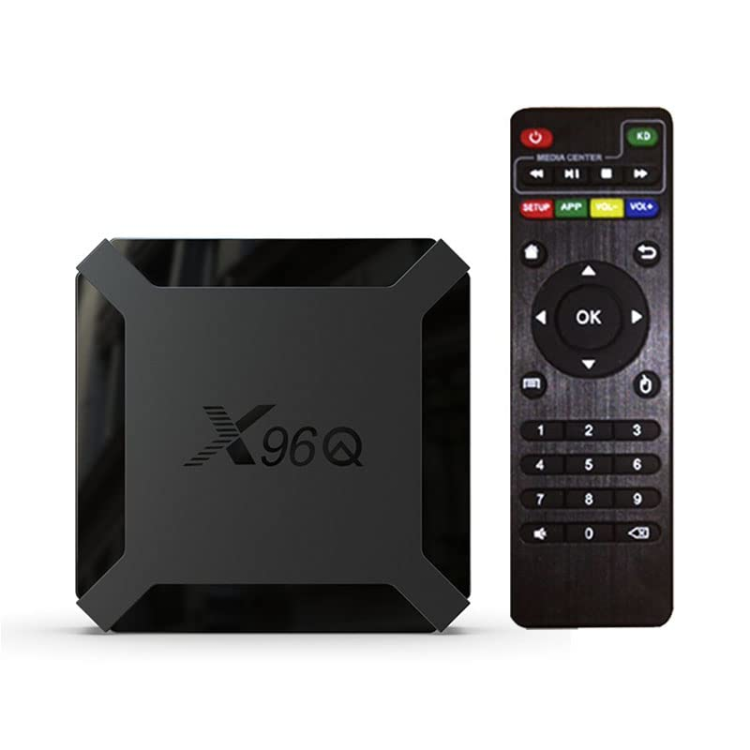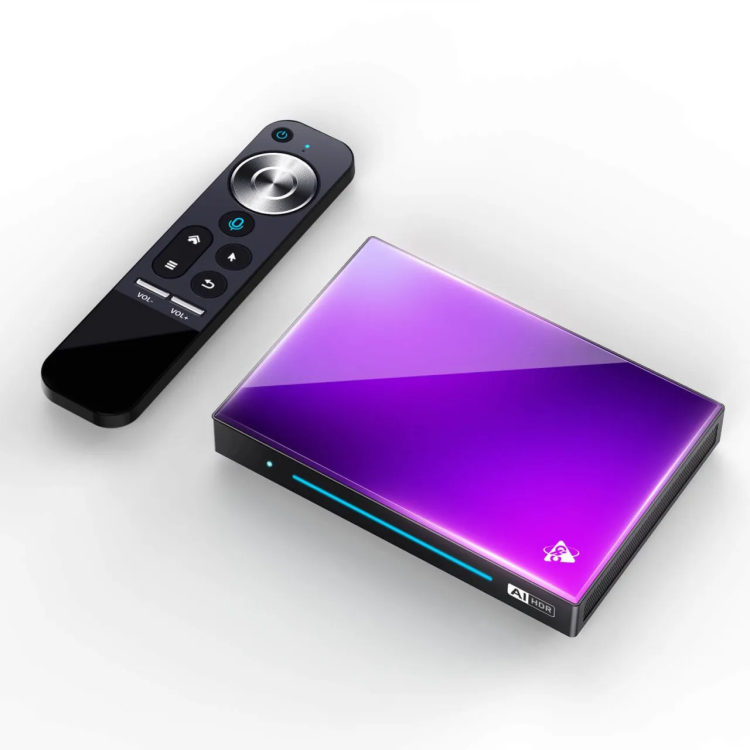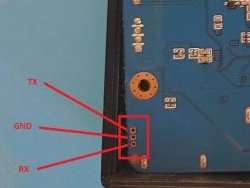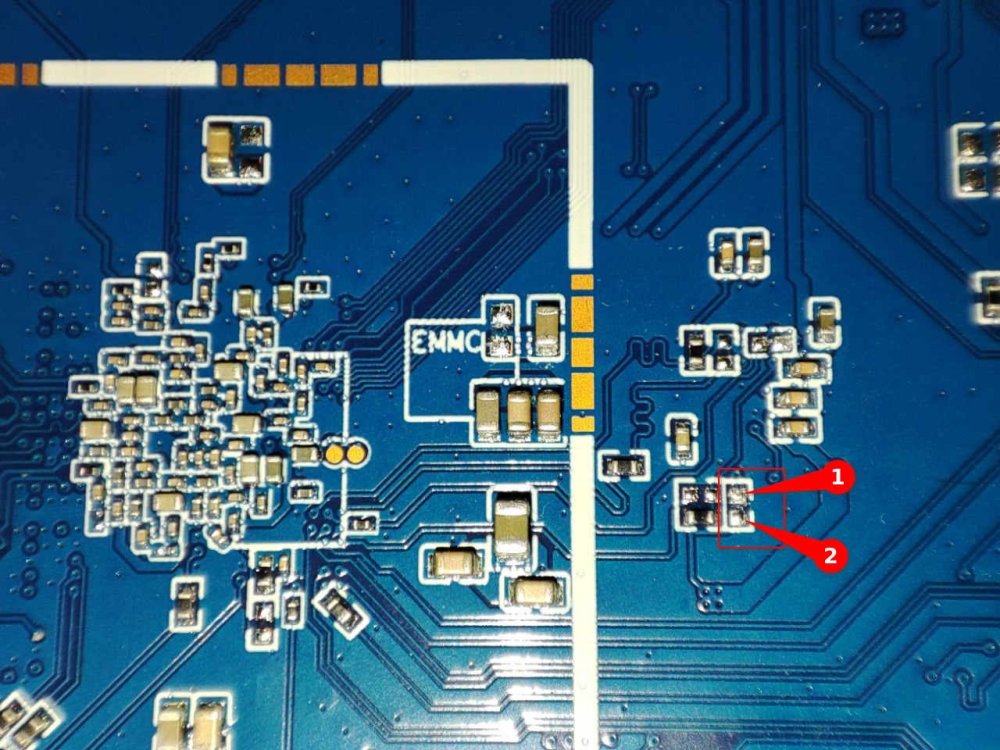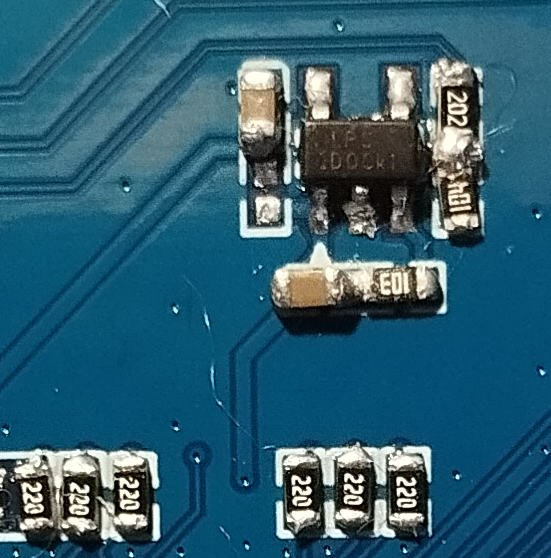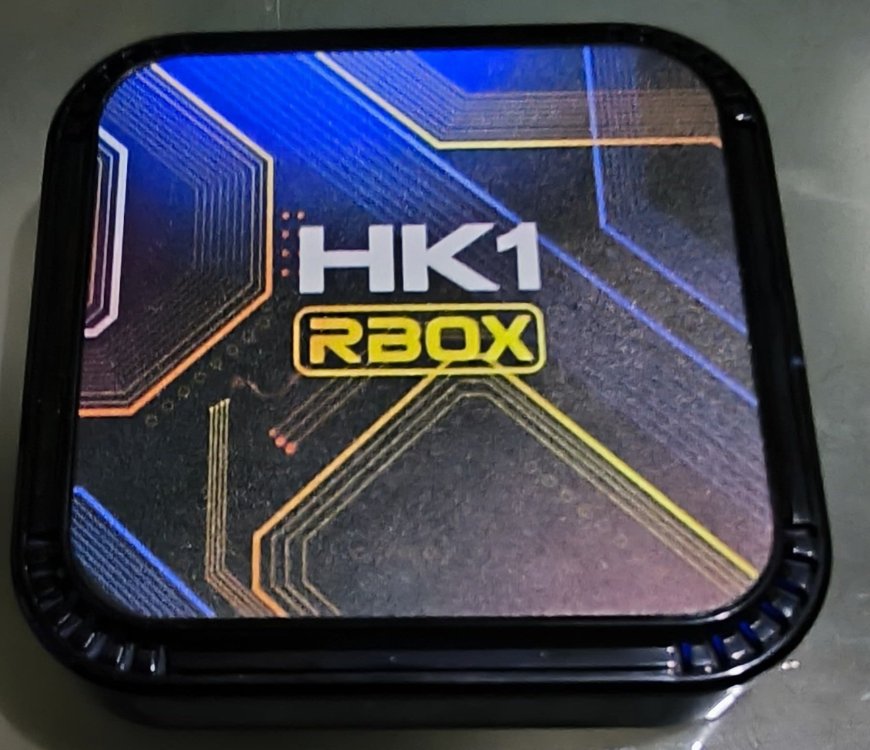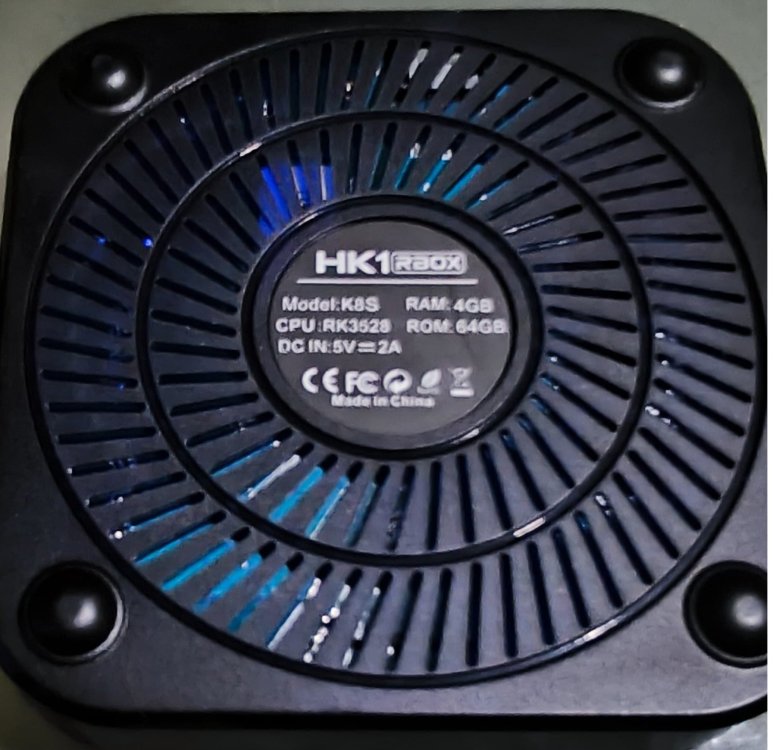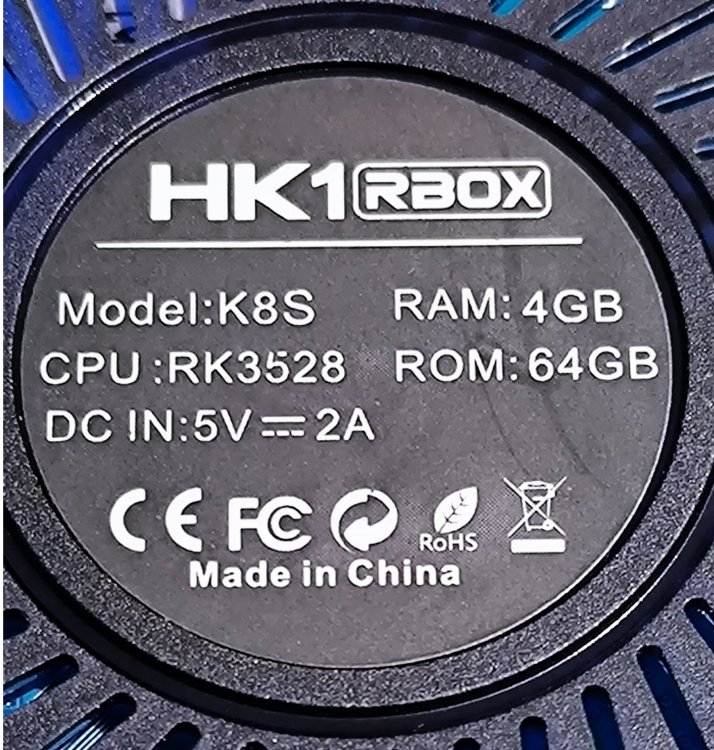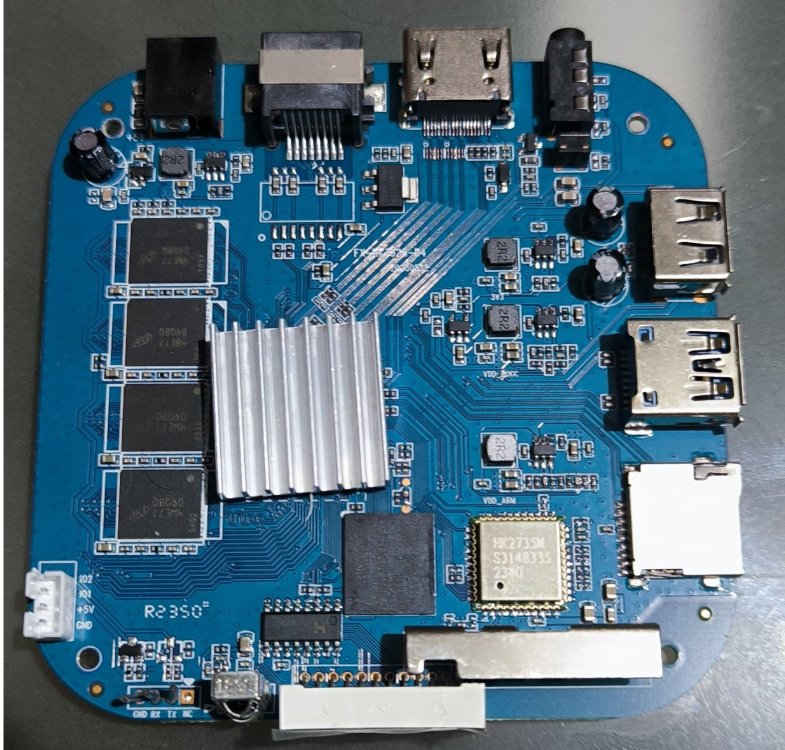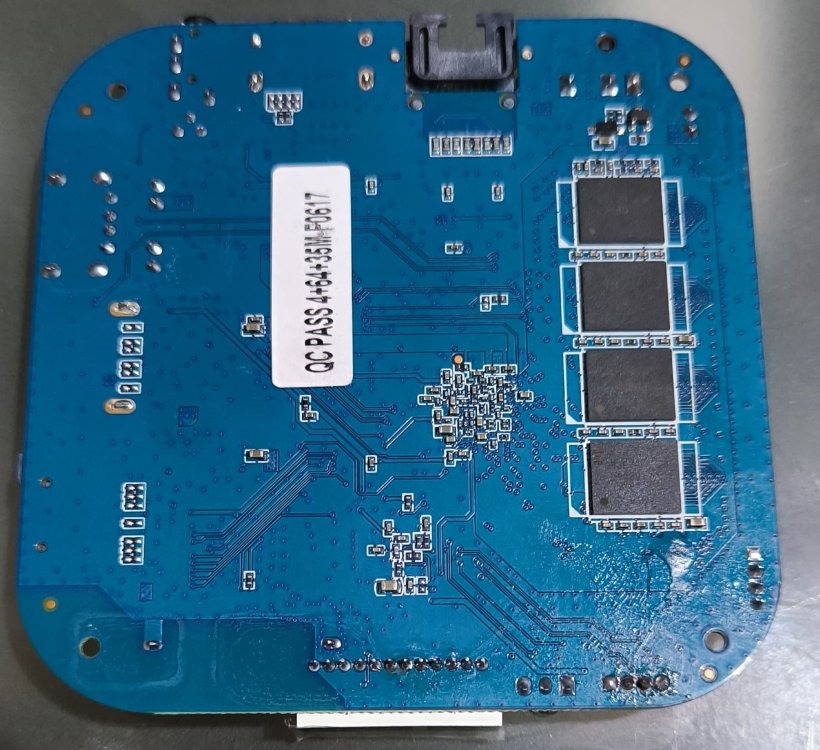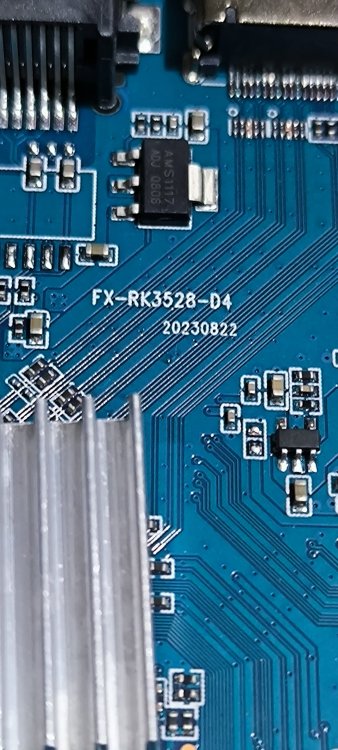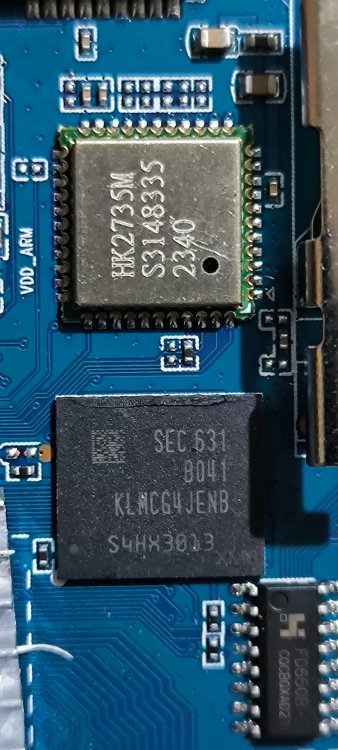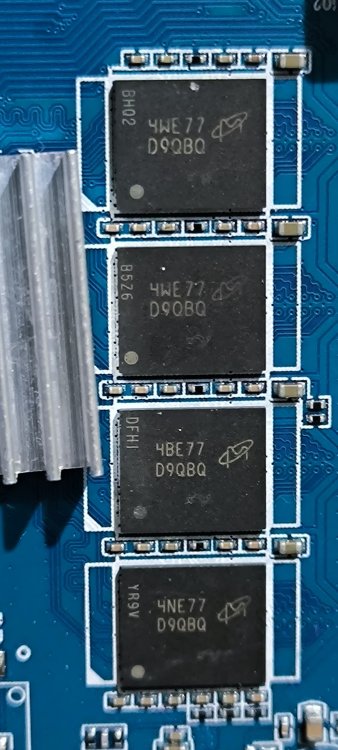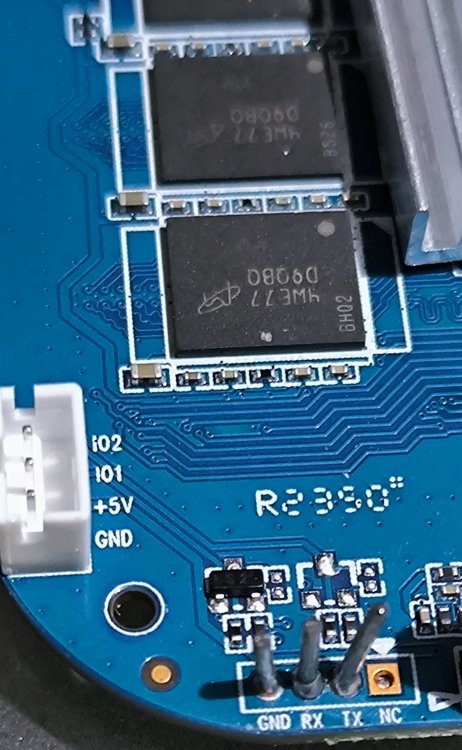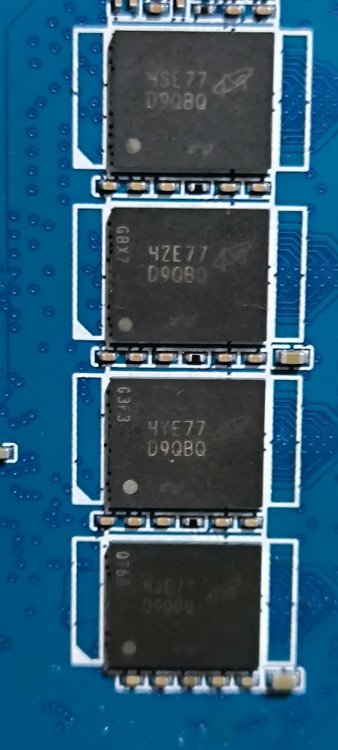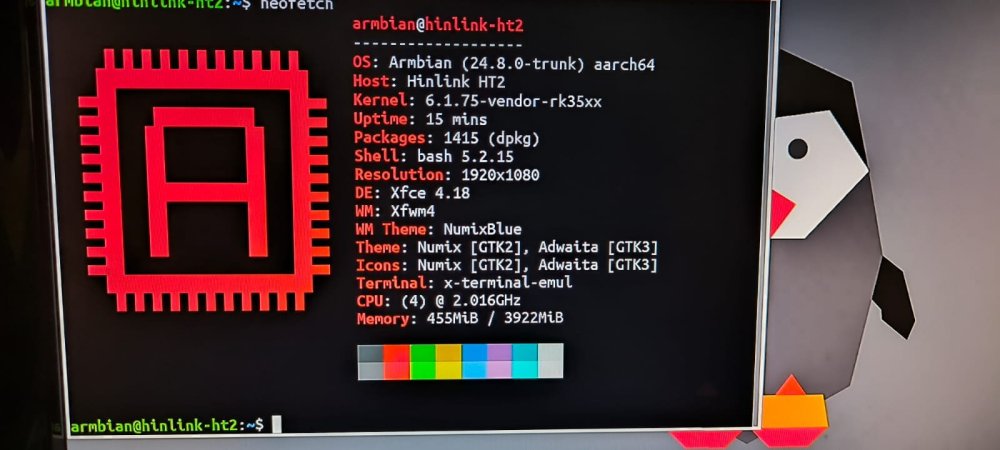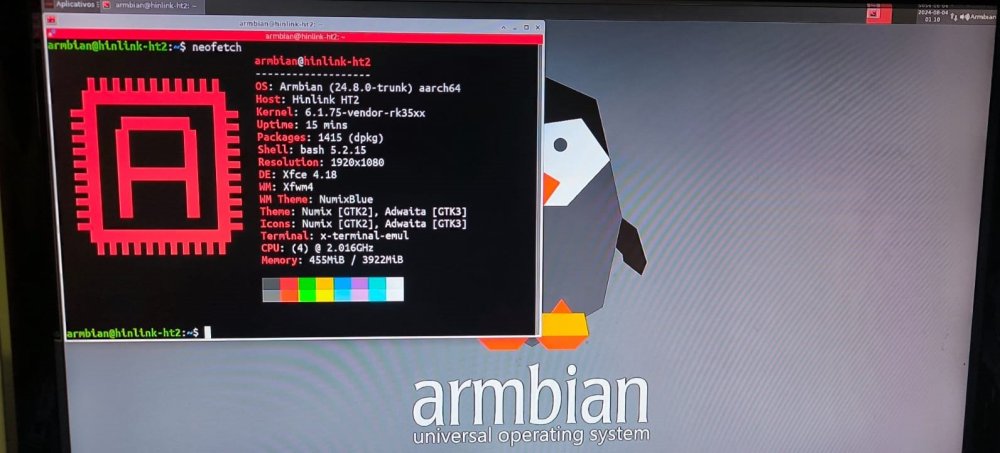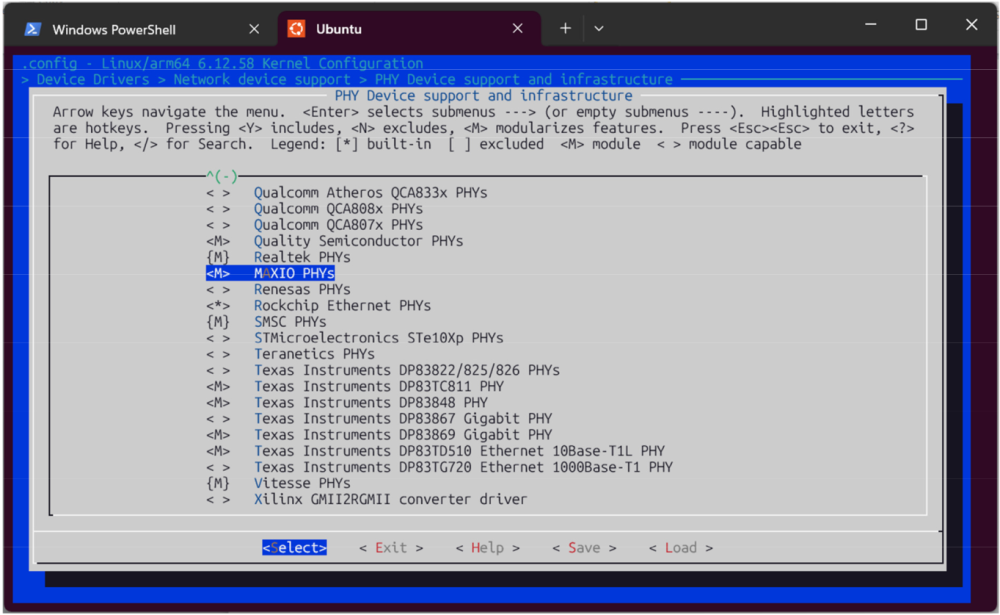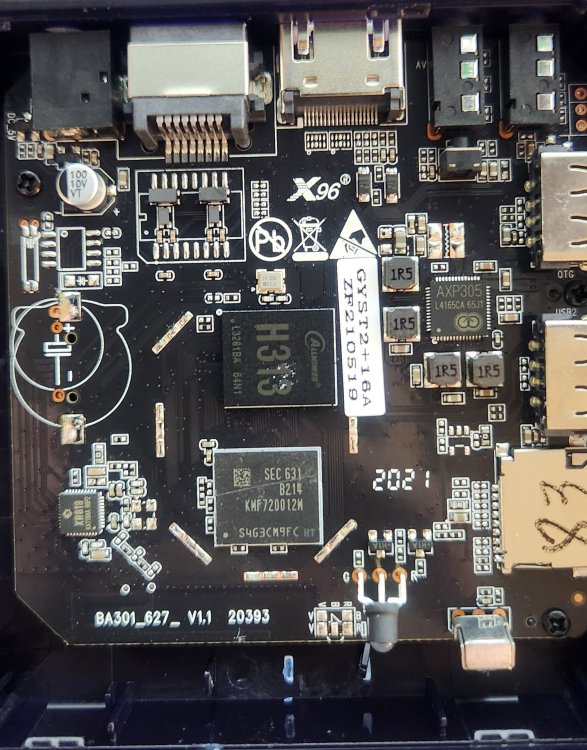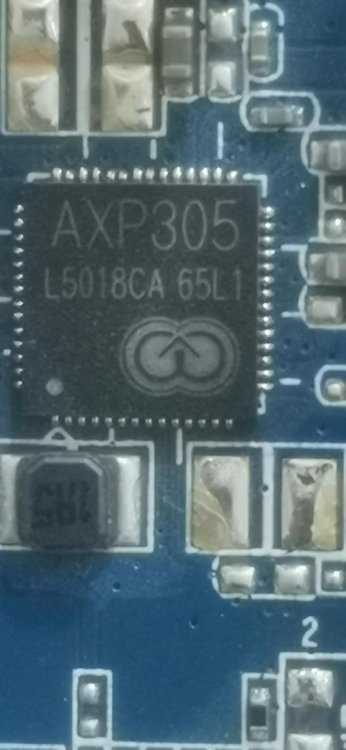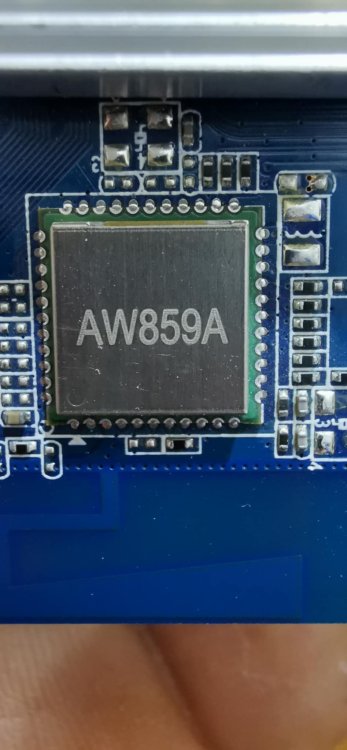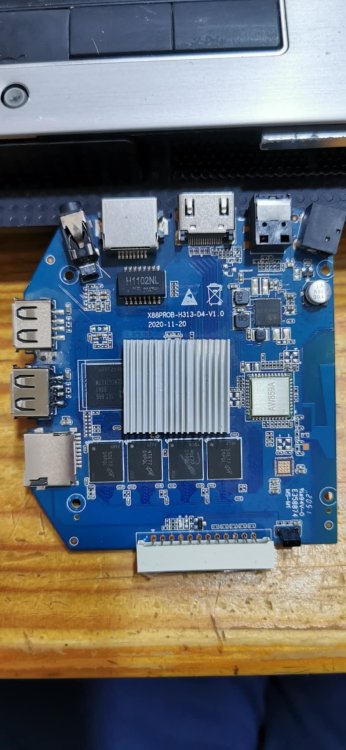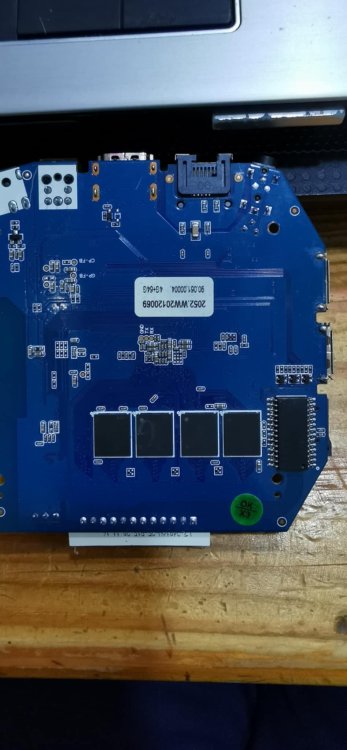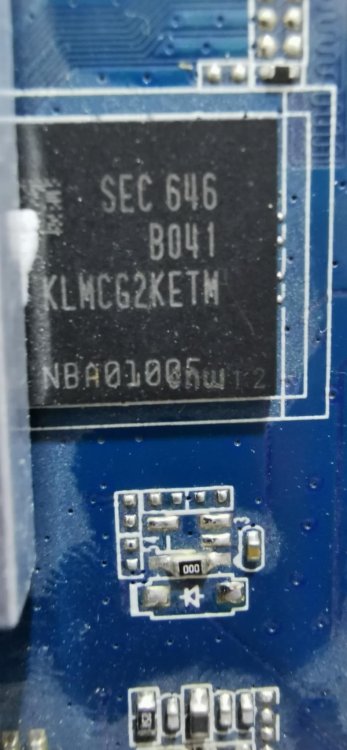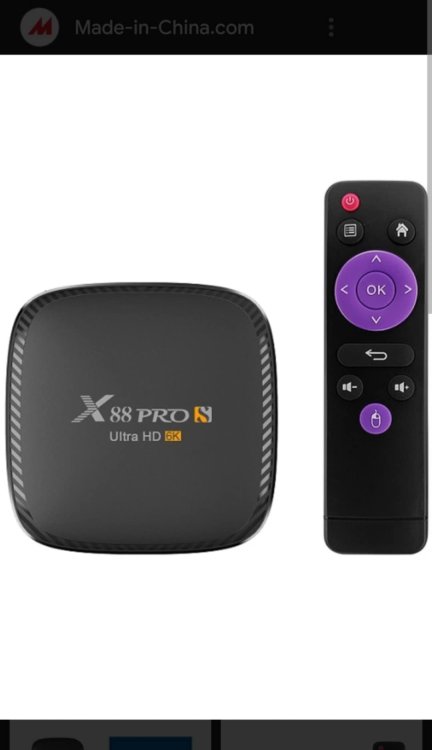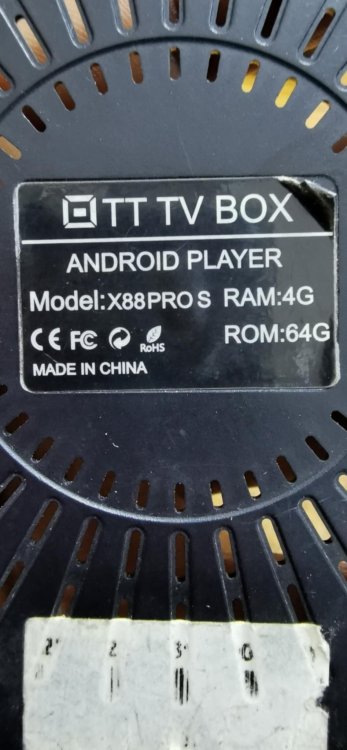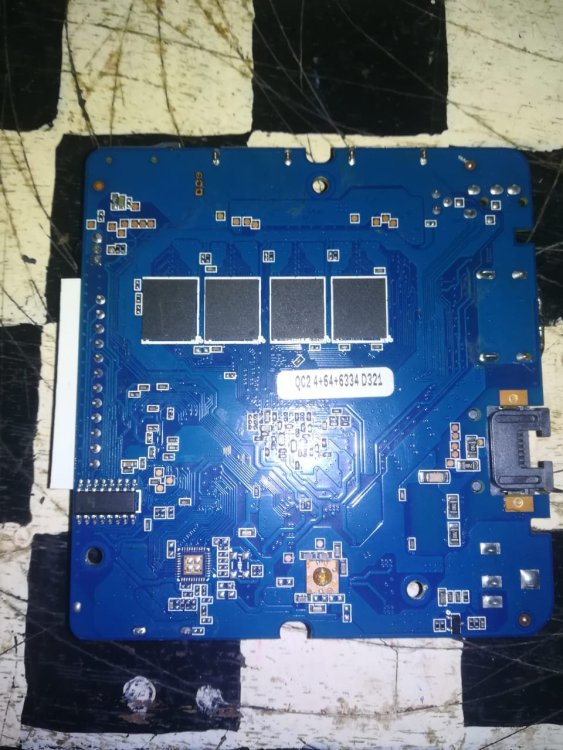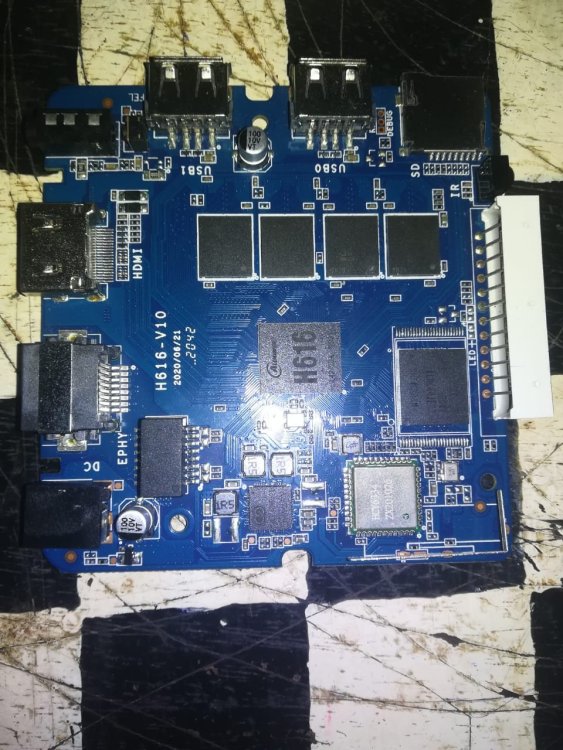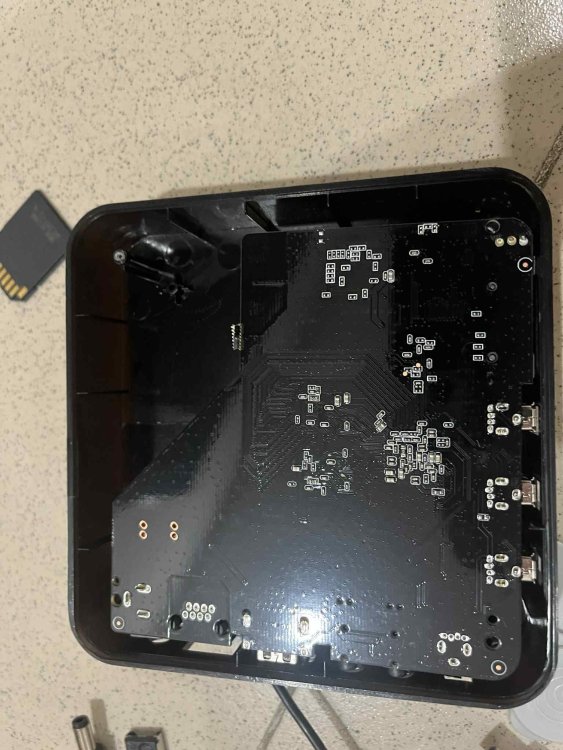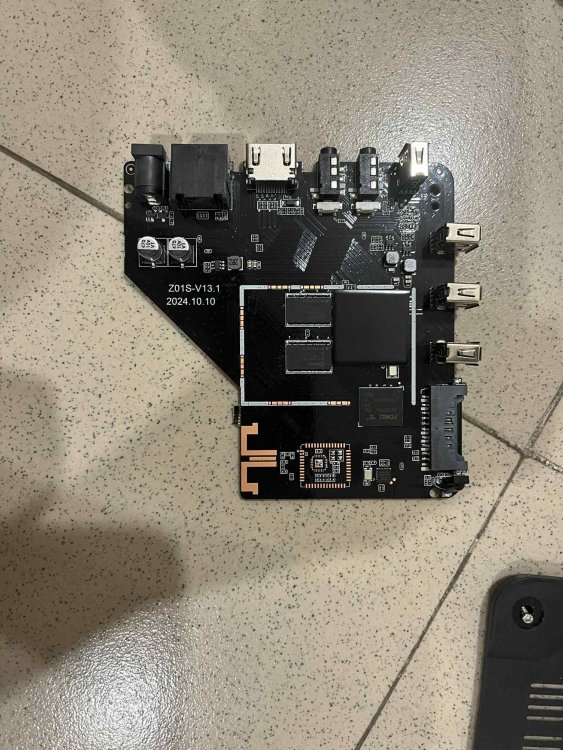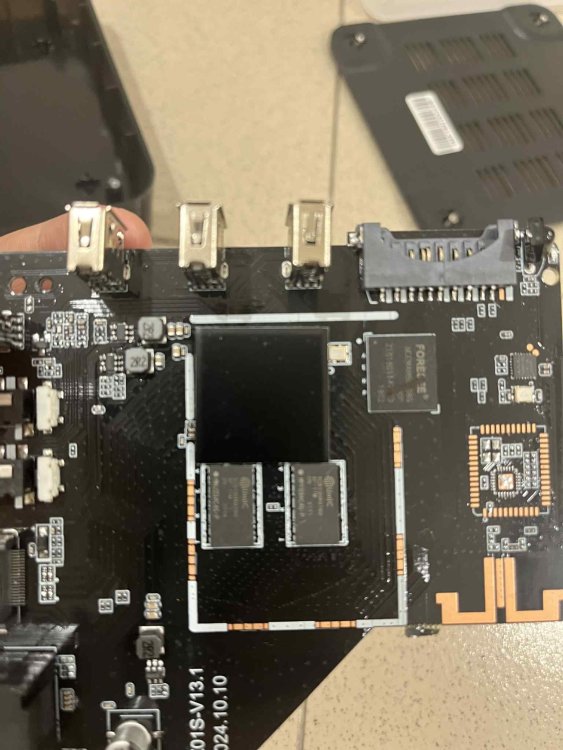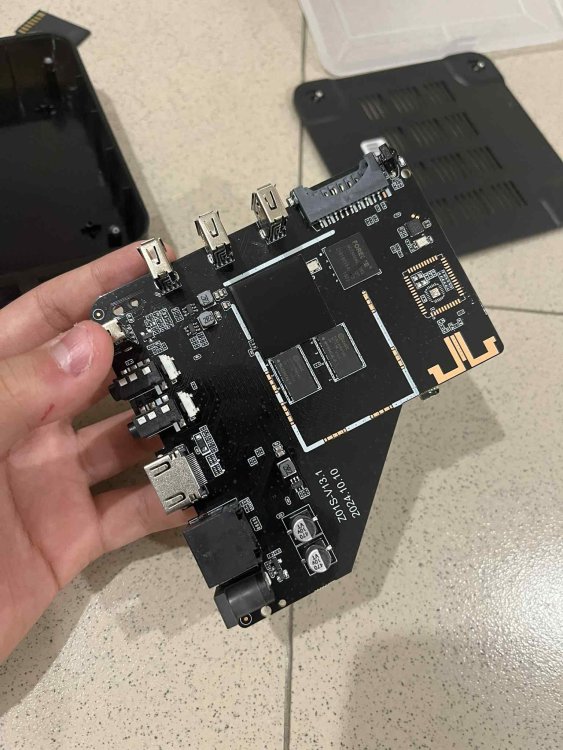Search the Community
Showing results for 'tv'.
-
Currently working on a build for this device. It boots and is about 90% functional on 6.6 and 6.7 Kernel https://github.com/sicXnull/armbian-build/tree/X96Q-TVBOX-LPDDR3 Working - Desktop - Ethernet - Wifi Not working - DTS could use some work. Right now it does not detect internal EMMC so installing to EMMC is not an option. - Likely other things i've missed. I've uploaded two images to my git. Full w/Mate Desktop Minimal/Server Feel free to compile this yourself if you don't trust my images, it's encouraged. Changes are on the X96Q-TVBOX-LPDDR3 Branch Full W/Desktop ./compile.sh build BOARD=x96q-tvbox BRANCH=current BUILD_DESKTOP=yes BUILD_MINIMAL=no EXPERT=yes KERNEL_CONFIGURE=no KERNEL_GIT=shallow RELEASE=bookworm Minimal/Server ./compile.sh build BOARD=x96q-tvbox BRANCH=current BUILD_DESKTOP=no BUILD_MINIMAL=yes EXPERT=yes KERNEL_CONFIGURE=no KERNEL_GIT=shallow RELEASE=bookworm
-
🏆 Become a sponsor, help to add other boards in armbian standart, you don't need to be a programmer to help the community, just need a copy of the ARM BOARD and a x86 computer to compile new versions. If you like what you see here and want to help: Donate Armbian the like button only costs a few dollars. Armbian Needs you help! Product Specification: Chipset: Rockchip RK3576 Octa Core ARM Mali G52 MC3 WIFI: WiFi6 11ax 1x1 80 MHz wifi controller: AP6275P RAM: DDR4 4GB/8GB ROM: eMMC 32GB/64GB/128GB OS: Android 14.0 || Armbian Vendor 6.1 Ethernet: 1000M Standard RJ-45 Bluetooth: BT 5.0 The RK3576 is indeed a lower-cost SoC but features four Cortex-A72 and four Cortex-A53 cores instead Android Base Files: H96-RK3576-ANDROID.dts H96-RK3576-ANDROID.dts H96-RK3576-BOX.dtb H96-RK3576-BOX.dtb RK3576_MiniLoaderAll.bin Vendor Kernel DTS: @RealAn H96-RK3576-VENDOR.dts Mainline status: Verify wifi controller: AP6275P Wifi Driver: https://drive.google.com/file/d/1n6x4tg5Xh24nWllOTJTq1ldVyDkK8W2Q/view?usp=sharing Flashing Tools: https://drive.google.com/file/d/1nLgPCBN0qmbzufWDFmISYc92JUpvwMPc/view?usp=sharing build_armbian.csc: https://drive.google.com/file/d/1VNR5QJlPylPsce9PI9O2TB3wOpshK2Bh/view?usp=sharing @hzdm Stock Firmware: method https://drive.google.com/file/d/1zLGvIxLE6vf8iSTjsyEr-Ly4MZ6ZahBB/view?usp=sharing Flashing Firmware Tutorial Factory Firmware for H96 Max M9 https://disk.yandex.ru/d/pWGEtRel0P9ejg https://drive.google.com/drive/folders/1g63F8fGSLEA9iK2_Mqzd6F0xfaTRnGlm?usp=sharing Factory Firmware for H96 Max M9S https://disk.yandex.ru/d/H17eGTYCjgmCsg https://drive.google.com/drive/folders/1Q360l5XbTVsWIvWkqy2xJ0sLpqHRSApM?usp=sharing TTL debug: RX TX GND pins: Enable SDCARD Reader: @rustamt method from 4pda Force board Maskrom Mode Maskrom Pins:
-
DISCLAIMER (PLEASE READ): everything you can find in this thread (binaries, texts, code snippets, etc...) are provided AS-IS and are not part of official Armbian project. For this reason not people from Armbian project nor myself are responsible for misuse or loss of functionality of hardware. Please don't ask about support or assistance in other non-community forums nor in the official Armbian github repository, instead post your questions in this thread, in the TV Boxes forum section (hardware related) or in the Peer-to-peer support section (general linux/software related). Thank you! This thread is to give stable and mature long-term range support to rk3318/rk3328 found in many tv boxes in Armbian project as Community Supported Configuration (CSC). The current work is mainlined into Armbian project, but your mileage may vary; most recent developments live on my personal fork on github -> here <- Important notes: is just a personal opinion, but apparently widely supported, that rk3318 chip is not an official rockchip part. They probably are scrap rk3328 parts which have not passed conformance tests but are sold anyway to tv boxes manufacturers. They don’t reach the same operating frequency of the rk3328, have much higher leakage currents (and thus higher temperatures) and often the boards they are installed on are low quality with low quality components, in fact a very very common issue is the eMMC failure due to bad parts and bad soldering. So said, I personally suggest not to buy any rk3318 tv box, but instead find a properly supported SBC (Single Board Computer) if you need a reliable product. In the unfortunate case you already have such product, this thread may help you have some fun with them. What works: • Works on RK3318 and RK3328 TV boxes with DDR3 memories • Mainline u-boot • Mainline ATF provided as Trusted Execution Environment • All 4 cores are working • Ethernet • Serial UART (configured at stock 1.5Mbps) • Thermals and frequency scaling • OTG USB 2.0 port (also as boot device!) • EHCI/OHCI USB 2.0 ports and XHCI USB 3.0 ports • MMC subsystem (including , SD and sdio devices) • Hardware video acceleration (fully supported via RKMPP on legacy kernel, support via hantro and rkvdec kernel driver on mainline) • Various WIFI over SDIO are supported • Full acceleration on legacy kernel and mainline kernel • U-boot boot order priority: first the sdcard, then the USB OTG port and eventually the internal ; you can install u-boot (and the whole system) in the internal and u-boot will always check for images on external sdcard/USB first. Unbrick: Technically, rockchip devices cannot be bricked. If the internal flash does not contain a bootable system, they will always boot from the sdcard. If, for a reason, the bootable system on the internal flash is corrupted or is unable to boot correctly, you can always force the maskrom mode shorting the clock pin on the PCB. The procedure is explained here for rk322x, but for rk3318/28 is the same. In most of the rk3318/28 boards, shorting the clock pin is difficult or impossible because eMMC are BGA chips with no exposed pins. Pay double attention when burning something on the internal flash memory and always test first the image booting from the sdcard to be sure it works before burning anything in internal flash. This is a list of posts where forum users have been able to spot the eMMC clock pin to trigger the maskrom mode: H96 Max+ (board signature: RK3318_V1.4) by @Gausus X88 PRO 10 (board signature: X88_PRO_B) by @mathgaming HK1 Max (board signature YX_RK3318) by @Constantin Gatej Ninkbox N1 Max RK3318 by @enigmasphinx Hongtop H50 (board signature t98-3318-221-v11) by @GmP Partecipation and debugging: If you want to partecipate or need help debugging issues, do not hesitate to share your experience with the installation procedure of the boxes. In case of issues and missed support, provide as many as possible of these things is very useful to try and bring support for an unsupported board: some photos of both sides of the board. Details of the eMMC, DDR and Wifi chips are very useful! upload the device tree binary (dtb) of your device. We can understand a lot of things of the hardware from that small piece of data; and alternative is a link to the original firmware (you can do a full backup with the Multitool); dmesg and other logs (use armbianmonitor -u that automatically collects and uploads the logs online) attach a serial converter to the device and provide the output of the serial port; Multimedia: Mainline kernel: 3D acceleration is provided by Lima driver and is already enabled. Hardware video decoding: https://forum.armbian.com/topic/19258-testing-hardware-video-decoding-rockchip-allwinner/ Legacy kernel: If you need multimedia features, like OpenGL/OpenGL ES acceleration, hardware accelerated Kodi, ffmpeg and mpv you can take a look to this post Installation (via SD card): Building: You can build your own image follow the common steps to build armbian for other tv boxes devices: when you are in the moment to choose the target board, switch to /TVB/ boards and select "rk3318-box" from the list. Prebuilt images: Nightly stables - built from trunk by Armbian servers and GPG-signed: https://github.com/armbian/community Multitool: Multitool - A small but powerful image for RK3318/RK3328 TV Box maintenance. Download it from here Quick installation instructions on eMMC: Build or download your preferred Armbian image and a copy of the Multitool; Burn the Multitool on an SD card; once done, place the Armbian image in images folder of the SD card NTFS partition; Plug the SD card in the TV box and plug in the power cord. After some seconds the blue led starts blinking and the Multitool appears; OPTIONAL: you can do a backup of the existing firmware with "Backup flash" menu option; Choose "Burn image to flash" from the menu, then select the destination device (usually mmcblk2) and the image to burn; Wait for the process to complete, then choose "Shutdown" from main menu; Unplug the power cord and the SD card, then replug the power cord; Wait for 10 seconds, then the led should start blinking and HDMI will turn on. The first time the boot process will take a couple of minutes or more because the filesystem is going to be resized, so be patient and wait for the login prompt. On first boot you will be asked for entering a password for root user of your choice and the name and password for a regular user Run rk3318-config to configure the board specific options Run armbian-config to configure timezone, locales and other personal options Congratulations, Armbian is now installed! Despite the procedure above is simple and reliable, I always recommend to first test that your device boots Armbian images from SD Card. Due to the really large hardware variety, there is the rare chance that the images proposed here may not boot. If a bad image is burned in , the box may not boot anymore forcing you to follow the unbrick section at the top of this post. Quick installation instructions to boot from SD Card: If you are already running Armbian from eMMC, skip to the next step. Instead if you are running the original firmware you need to first erase the internal flash; to do so download the Multitool, burn it on an SD Card, plug the SD Card and power the TV Box. Use "Backup flash" if you want to do a backup of the existing firmware, then choose "Erase flash" menu option. Build or download your preferred Armbian image; Uncompress and burn the Armbian image on the SD Card; Plug the SD Card in the TV Box and power it on; Wait for 10 seconds, then the led should start blinking and HDMI will turn on. The first time the boot process will take a couple of minutes or more because the filesystem is going to be resized, so be patient and wait for the login prompt; On first boot you will be asked for entering a password for root user of your choice and the name and password for a regular user Run rk3318-config to configure the board specific options Run armbian-config to configure timezone, locales and other personal options, or also to transfer the SD Card installation to internal ; Congratulations, Armbian is running from SD Card! Tutorial - How to install Armbian on your TV Box (by @awawa) : https://www.hyperhdr.eu/2022/01/tv-box-mania-i-part-x88-pro-10.html A note about boot device order: With Armbian also comes mainline U-boot. If you install Armbian, the bootloader will look for valid bootable images in this order: External SD Card External USB Stick in OTG Port Internal The Multitool does not boot / How to burn image directly on eMMC: Some boards have the sdcard attached to an auxiliary (called also sdmmc_ext or external) controller which is not the common one. Forum findings declare that those boards are not able to boot from sdcard with stock firmware and they neither do in maskrom mode: the stock firmware always boots even if you put the multitool on sdcard. In such case, burning images directly on eMMC is the only way to have a working Armbian installation. You can follow these instructions by @fabiobassa to burn images directly on eMMC: https://forum.armbian.com/topic/17597-csc-armbian-for-rk3318rk3328-tv-box-boards/?do=findComment&comment=130453 Notes and special hardware: Script to change DDR memory frequency here Wireless chip AP2734, SP2734, HY2734C and similars: they are clones of AmPAK AP6334 which is combo wifi + bluetooth of broadcom BCM4334/B0 chips. You may need a special nvram file, instructions by @paradigman are here Critics, suggestions and contributions are welcome! Credits: @fabiobassa for his ideas, inspiration, great generosity in giving the boards for development and testing. The project of bringing rk3318 into armbian would not have begun without his support! @hexdump for his precious support in early testing, ideas and suggestions @MX10.AC2Nfor his patience in testing mxq-rk3328-d4 board support All the rockhip64 maintainers at Armbian project who have done and do most of the work to support the platform
- 1950 replies
-
19
-
DISCLAIMERS (PLEASE READ): Everything you can find in this thread (binaries, texts, code snippets, etc...) are provided AS-IS and are not part of official Armbian project. For this reason not people from Armbian project nor myself are responsible for misuse or loss of functionality of hardware. THIS POST explains very well the troubles with TV Boxes and why they are not suitable for everyone Please don't ask about support or assistance in other non-community forums nor in the official Armbian github repository, instead post your questions in this thread, in the TV Boxes forum section (hardware related) or in the Peer-to-peer support section (general linux/software related). Following the recent thread on LibreElec forum about an unofficial image for rk3229 devices, I would like to make public the work made by me and @fabiobassa about bringing rk322x support to armbian. The project is now in -> mainline Armbian <- development fork -> here <- This first page and the last 3 or 4 pages of the thread are enough to get up to date with recent developments. Many useful experiences are scattered through the thread, but the most important things are collected here in the first page, so please read it carefully! Mainline kernel is fully supported and will receive most support in the future. Legacy kernel 4.4 is deprecated, but is kept around only for special purposes. What works: Should boot and work flawlessy on all boards with RK3228a, RK3228b and RK3229, with either DDR2 and DDR3 memories. Mainline u-boot Proprietary OPTEE provided as Trusted Execution Environment (needed for DRAM frequency scaling) All 4 cores are working Ethernet Serial UART (configured at 115200 bps, not 1.5Mbps!) Thermals, CPU and DRAM frequency scaling OTG USB 2.0 port (also as boot device!) EHCI/OHCI USB 2.0 ports MMC subsystem (including eMMC, SD and sdio devices) Hardware video acceleration NAND is available only on legacy kernel. To fully boot from NAND, use the Multitool and its steP-nand installation (instructions are below) Various WIFI over SDIO are supported (SSV6051P, SSV6256P, ESP8089, Realtek chips, etc...), ssv6256p driver is available only on legacy kernel Full GPU acceleration U-boot boot order priority: first the sdcard, then the USB OTG port and eventually the internal eMMC; you can install u-boot (and the whole system) in the internal eMMC and u-boot will always check for images on external sdcard/USB first. Unbrick: Technically, rockchip devices cannot be bricked. If the internal flash does not contain a bootable system, they will always boot from the sdcard. If, for a reason, the bootable system on the internal flash is corrupted or is unable to boot correctly, you can always force the maskrom mode shorting the eMMC clock pin on the PCB. Here there is the procedure, but you can also google around if you get stuck on a faulty bootloader, the technique is pretty simple and requires a simple screwdriver. There are however some unfortunate cases (expecially newer boards) where shorting the eMMC clock pin is difficult or impossibile, like eMMC or eMCP BGA chips with no exposed pins. In those cases pay double attention when burning something on the internal eMMC/eMCP and always test first the image from the sdcard to be sure it works before burning anything on eMMC/eMCP. Some useful links with pins, pads or procedures for some boards: Generic procedure for boards with non-BGA eMMC MXQPRO_V71 - eMCP H20 - eMCP ZQ01 - eMCP NAND vs eMMC vs eMCP difference: RK3228 and RK3229 tv boxes comes with three different flash memory chips: eMMC, NAND and eMCP. It does not depend upon the market name of the tv box and neither the internal board; manufacturers put whatever they find cheaper when they buy the components. NAND chip is just the non-volatile memory eMMC chip contains both the non-volatile memory plus a controller. eMCP chip contains the non-volatile memory, a controller for the non-volatile memory (like eMMC), but also contains a bank of DDR SDRAM memory on the same physical chip. The difference is very important, because eMMC and eMCP are far easier to support at various levels: the controller deals with the physical characteristics of the non-volatile memory, so the software has no to deal with. NAND chips instead are harder to support, because the software is required to deal with the physical characteristics and non-standard things that depends upon the NAND manufacturer. If you have a NAND chips you're unlucky because mainline kernel currently cannot access it, but also because you need special care and instructions explained later. You can discover if you have a NAND, eMMC or eMCP chip looking on the board are reading the signature on the flash memory chip. The Multitool (see later) also can detect which chip you have onboard: the program will warn you at startup if you have a NAND chip. NAND bootloader upgrade: IMPORTANT: don't do this is you have an eMMC or eMCP; skip this paragraph if you are unsure too! For very expert people who are having issues when (re)booting images, there is the chance to upgrade the bootloader on NAND. The NAND bootloader is nothing else than a regular idbloader (see official rockchip documentation) but contains some bits to correctly access the data on your flash memory. Upgrading requires to erase the existing flash content, in the worst case will require you to follow the Unbrick procedure above or restore an older but more compatible bootloader. If you are not mentally ready to overcome possible further issues, don't do this! The detailed instructions and the binaries are available at this post Multimedia: Mainline kernel: 3D acceleration is provided by Lima driver and is already enabled. Hardware video decoding: https://forum.armbian.com/topic/19258-testing-hardware-video-decoding-rockchip-allwinner/ Deprecated legacy kernel: multimedia features, like OpenGL/OpenGL ES acceleration, hardware accelerated Kodi, ffmpeg and mpv you can take a look to this post An effective tutorial from @Hai Nguyen on how to configure a box as a hi-quality music player using an USB audio card, and controlling it via remote control is available in this post Brief explanation about kernel naming: current kernel is the mainline LTS kernel version, most maintained and tested. This is the suggested version for production devices. If you don't know what to pick, pick this. legacy kernel (version 4.4) is provided by manufacturer; it is deprecated, unmaintained and not suggested. edge kernel is the development mainline kernel version, with experimental features and drivers; usually stable but perhaps suitable for production devices. You can switch from one kernel flavour to another using armbian-config or manually via apt. Installation (via SD card): Building: You can build your own image follow the common steps to build armbian for other tv boxes devices: when you are in the moment to choose the target board, switch to CSC/TVB/EOL boards and select "rk322x-box" from the list. Download prebuilt images from the following links: Archive builds (GPG-signed) - https://imola.armbian.com/dl/rk322x-box/archive/ SUGGESTED - Nightly built from trunk each week by Armbian servers (GPG-signed) - https://github.com/armbian/community Old images provided by me (unsigned and outdated) - https://users.armbian.com/jock/rk322x/armbian/stable Archived/older images: https://armbian.hosthatch.com/archive/rk322x-box/archive/ Multitool: The Multitool is a small but powerful tool to do quick backup/restore of internal flash, but also burn images and general system rescue and maintenance via terminal or SSH. Compressed images will be uncompressed on fly. Multitool - A small but powerful image for RK322x TV Box maintenance (instructions to access via network here) Quick installation instructions on eMMC: Build or download your preferred Armbian image and a copy of the Multitool; Burn the Multitool on an SD card; once done, place the Armbian image in images folder of the SD card NTFS partition; Plug the SD card in the TV box and plug in the power cord. After some seconds the blue led starts blinking and the Multitool appears; OPTIONAL: you can do a backup of the existing firmware with "Backup flash" menu option; Choose "Burn image to flash" from the menu, then select the destination device (usually mmcblk2) and the image to burn; Wait for the process to complete, then choose "Shutdown" from main menu; Unplug the power cord and the SD card, then replug the power cord; Wait for 10 seconds, then the led should start blinking and HDMI will turn on. The first time the boot process will take a couple of minutes or more because the filesystem is going to be resized, so be patient and wait for the login prompt. On first boot you will be asked for entering a password for root user of your choice and the name and password for a regular user Run sudo rk322x-config and select your board characteristics to enable leds, wifi chips, high-speed eMMC, etc... Run sudo armbian-config to configure timezone, locales and other personal options Congratulations, Armbian is now installed and configured! Despite the procedure above is simple and reliable, I always recommend to first test that your device boots Armbian images from SD Card. Due to the really large hardware variety, there is the rare chance that the images proposed here may not boot. If a bad image is burned in eMMC, the box may not boot anymore forcing you to follow the unbrick section at the top of this post. Quick installation instructions on NAND: Build or download your preferred Armbian image and a copy of the Multitool; Burn the Multitool on an SD card; once done, place the Armbian legacy kernel image in images folder of the SD card NTFS partition; Plug the SD card in the TV box and plug in the power cord. After some seconds the blue led starts blinking and the Multitool appears; OPTIONAL: you can do a backup of the existing firmware with "Backup flash" menu option; Choose "Burn Armbian image via steP-nand" from the menu, then select the destination device (usually rknand0) and the image to burn; Wait for the process to complete, then choose "Shutdown" from main menu; Unplug the power cord and the SD card, then replug the power cord; Wait for 10 seconds, then the led should start blinking and HDMI will turn on. The first time the boot process will take a couple of minutes or more because the filesystem is going to be resized, so be patient and wait for the login prompt. On first boot you will be asked for entering a password for root user of your choice and the name and password for a regular user Run sudo rk322x-config and select your board characteristics to enable leds, wifi chips, etc... Run armbian-config to configure timezone, locales and other personal options Congratulations, Armbian is now installed! Alternative: you can install the bootloader in NAND and let it boot from SD Card or USB: Download a copy of the Multitool and burn it on an SD card; Plug the SD card in the TV box and plug in the power cord. After some seconds the blue led starts blinking and the Multitool appears; RECOMMENDED: make a backup of the existing firmware with "Backup flash" menu option; Choose "Install Jump Start for Armbian" menu option: the Jump Start uses the internal NAND to boot from external SD Card or external USB Stick; Follow the general instructions to boot from SD Card below, skip the first erase eMMC step. Quick installation instructions to boot from SD Card: If you are already running Armbian from eMMC, skip to the next step. Instead if you are running the original firmware you need to first erase the internal eMMC; to do so download the Multitool, burn it on an SD Card, plug the SD Card and power the TV Box. Use "Backup flash" if you want to do a backup of the existing firmware, then choose "Erase flash" menu option. Build or download your preferred Armbian image; Uncompress and burn the Armbian image on the SD Card; Plug the SD Card in the TV Box and power it on; Wait for 10 seconds, then the led should start blinking and HDMI will turn on. The first time the boot process will take a couple of minutes or more because the filesystem is going to be resized, so be patient and wait for the login prompt; On first boot you will be asked for entering a password for root user of your choice and the name and password for a regular user Run sudo rk322x-config and select your board characteristics to enable leds, wifi chips, high-speed eMMC or NAND, etc... Run armbian-config to configure timezone, locales and other personal options, or also to transfer the SD Card installation to internal eMMC; Congratulations, Armbian is running from SD Card! A note about boot device order: With Armbian also comes mainline U-boot. If you install Armbian or just the bootloader in the eMMC or the Jump Start on internal NAND, the bootloader will look for valid bootable images in this order: External SD Card External USB Stick in OTG Port Internal eMMC Installation (without SD card, board with eMMC) If you have no sd card slot and your board has an eMMC, you can burn the armbian image directly on the internal eMMC using rkdeveloptool and a male-to-male USB cable: Download your preferred Armbian image from Armbian download page and decompress it. Download the rk322x bootloader: rk322x_loader_v1.10.238_256.bin Download a copy of rkdeveloptool: a compiled binary is available in the official rockchip-linux rkbin github repository. Unplug the power cord from the tv box Plug an end of an USB Male-to-male cable into the OTG port (normally it is the lone USB port on the same side of the Ethernet, HDMI, analog AV connectors) while pressing the reset microbutton with a toothpick. You can find the reset microbutton in a hole in the back of the box, but sometimes it is hidden into the AV analog jack Plug the other end of the USB Male-to-male cable into an USB port of your computer If everything went well, run lsusb: you should see a device with ID 2207:320b Run sudo rkdeveloptool rd 3 (if this fails don't worry and proceed to next step) Run sudo rkdeveloptool db rk322x_loader_v1.10.238_256.bin Run sudo rkdeveloptool wl 0x0 image.img (change image.img this with the real Armbian image filename) Unplug the power cord Done! Installation (without SD card, board with NAND) If you are in the unfortunate case you can't use an SD card for installation and your board has a NAND chip, you still have an option to use the quick Multitool installation steps via USB. Obtain a copy of rkdeveloptool: a compiled binary is available in the official rockchip-linux rkbin github repository. Unplug the power cord from the tv box Plug an end of an USB Male-to-male cable into the OTG port (normally it is the lone USB port on the same side of the Ethernet, HDMI, analog AV connectors) while pressing the reset microbutton with a toothpick. You can find the reset microbutton in a hole in the back of the box, but sometimes it is hidden into the AV analog jack Plug the other end of the USB Male-to-male cable into an USB port of your computer If everyting went well, using lsusb you should see a device with ID 2207:320b Run sudo rkdeveloptool wl 0x4000 u-boot-main.img (download u-boot-main.img.xz , don't forget to decompress it!) Unplug the power cord Now you can follow the instructions on how to install on eMMC/NAND via SD card, just use instead an USB stick to do all the operations and plug it into the USB OTG port. Once you reboot, USB OTG port will be used as a boot device. NOTE: NAND users without SD slot may be unhappy to know that it will be difficult to do extra maintenance with Multitool in case something breaks in the installed Armbian system: installing u-boot-main.img makes the installed system unbootable because it is missing the NAND driver. Alternative backup, restore and erase flash for EXPERTS: These backup, restore and erase flash procedures are for experts only. They are kept here mostly for reference, since the Multitool is perfectly able to do same from a very comfy interface and is the suggested way to do maintenance. Backup: Obtain a copy of rkdeveloptool: a compiled binary is available in the official rockchip-linux rkbin github repository. If you prefer, you can compile it yourself from the sources available at official rockchip repository Unplug the power cord from the tv box Plug an end of an USB Male-to-male cable into the OTG port (normally it is the lone USB port on the same side of the Ethernet, HDMI, analog AV connectors) while pressing the reset microbutton with a toothpick. You can find the reset microbutton in a hole in the back of the box, but sometimes it is hidden into the AV analog jack Plug the other end of the USB Male-to-male cable into an USB port of your computer If everyting went well, using lsusb you should see a device with ID 2207:320b change directory and move into rkbin/tools directory, run ./rkdeveloptool rfi then take note of the FLASH SIZE megabytes (my eMMC is 8Gb, rkdeveloptool reports 7393 megabytes) run ./rkdeveloptool rl 0x0 $((FLASH_SIZE * 2048)) backup.data (change FLASH_SIZE with the value you obtained the step before) once done, the internal eMMC is backed up to backup.data file Restore: first we have to restore the original bootloader, then restore the original firmware. Running rkdeveloptool with these switches will accomplish both the jobs: ./rkdeveloptool db rk322x_loader_v1.10.238_256.bin Downloading bootloader succeeded. ./rkdeveloptool ul rk322x_loader_v1.10.238_256.bin Upgrading loader succeeded. ./rkdeveloptool wl 0x0 backup.data Write LBA from file (100%) Download here: Erase the flash memory: clearing the internal eMMC/NAND memory makes the SoC look for external SD Card as first boot option. If there isn't any suitable SD Card, the SoC enters maskrom mode, which can then be used for full eMMC/NAND access using rkdeveloptool. This is perfectly fine if your box has an eMMC flash memory. NOTE: In case you have a NAND flash memory this option is however discouraged. The original bootloader contains some special parameters to correctly access the data. Clearing the flash memory will probably garbage the NAND data and restoring the bootloader may require some special instructions. Obtain a copy of rkdeveloptool: a compiled binary is available in the official rockchip-linux rkbin github repository. If you prefer, you can compile it yourself from the sources available at official rockchip repository Unplug the power cord from the board Plug an end of an USB Male-to-male cable into the OTG port (normally it is the lone USB port on the same side of the Ethernet, HDMI, analog AV connectors) while pressing the reset microbutton with a toothpick. You can find the reset microbutton in a hole in the back of the box, but sometimes it is hidden into the AV analog jack Plug the other end of the USB Male-to-male cable into an USB port of your computer If everyting went well, using lsusb you should see a device with ID 2207:320b run ./rkdeveloptool ef and wait a few seconds once done, the internal eMMC is erased and the device will boot from the sdcard from now on Partecipation and debugging: If you want to partecipate or need help debugging issues, do not hesitate to share your experience with the installation procedure of the boxes. In case of issues and missed support, provide as many as possible of these things is very useful to try and bring support for an unsupported board: some photos of both sides of the board. Details of the eMMC, DDR and Wifi chips are very useful! upload the device tree binary (dtb) of your device. We can understand a lot of things of the hardware from that small piece of data; and alternative is a link to the original firmware (you can do a full backup with the Multitool); dmesg and other logs (use armbianmonitor -u that automatically collects and uploads the logs online) attach a serial converter to the device and provide the output of the serial port; Critics, suggestions and contributions are welcome! Credits: @fabiobassa for his ideas, inspiration, great generosity in giving the boards for development and testing. The project of bringing rk322x into armbian would not have begun without his support! Justin Swartz, for his work and research to bring mainline linux on rk3229 (repository here) @knaerzche for his great contribution to libreelec support and mainline patches @Alex83 for his patience in testing the NAND bootloader upgrade procedure on his board @Jason Duhamell for his generous donation that allowed researching eMCP boards and esp8089 wifi chip
- 2984 replies
-
23
-
Good day all, After compiling a build for my TV box and burn it to the SD boot process stuck to Begin: Mounting root file system ... Begin: Running /scripts/local-top ... done. Begin: Running /scripts/local-premount ... Scanning for Btrfs filesystems Can someone help please solving the problem?
-

Efforts to develop firmware for Lemfo HK1 RBOX K8S 4G/64G
Panda posted a topic in Rockchip CPU Boxes
Hello People, I Bring to you the Lemfo HK1 RBOX K8S 4G/64G. This box came with Android 13 and can be rooted easy, follow some specs of the box: Processor: Rockchip RK3528 GPU: Mali 450 Memory: 4Gb (micron) Storage: 64Gb (eMMC 5.1 Samsung) Network: PHY Integrated stmmac-0:02 Driver RK630 100Mbps Wireless: 5G driver: rtl8822cs on gpio Bluetooth: 5.1 USB 3.0: 01 5Gbps USB 2.0: 01 HDMI: 01 TV-Out: 01 Power: 5v 2A Aliexpress link: Lemfo HK1 Rbox K8S What is Working: HDMI: partial (read bellow) Network: partial (read bellow) Bluetooth: no Wifi: no USB 3.0: yes Sound: yes over HDMI Obs: You need to use hinlink-ht2 image, but no wireless, nor ethernet, only HDMI work, and you need to turn on monitor around 15 seconds after turn on the TVBox I get the FDT from Android, and this FDT with hilink-ht2 images boot without HDMI, but with network, if you boot with hinlink-ht2 make the initial configs and start the desktop you can replace the rk-3528-hinlink-ht2.dtb with the android FDT and the box will boot, wait around 30 seconds and turn on the monitor and you have the HDMI and network working. I have build the image with xfce and include some drivers (mail450, RK630, rtl8822cs) and enable some DRM options (under test yet) I Have the Andoid boot partition dump, and other partions, I will share the files later (need some dropbox os gdrive to share) I have attached the Android.DTB and dmesg from android and armbian, if someone want take a look. Any help and sugestion will be great! Some pictures of the board: Lemfo-hk1rbox-k8s.dtb android_dmesg.log linux_dmesg.log linux-syslog -
Help for install ambian 22 or 23 in box TV with soc rk3528 i have instaled in box with amlogic no problème but with rockchip no support no boot......
-
🏆 Become a sponsor, help to add other boards in armbian standart, you don't need to be a programmer to help the community, just need a copy of the ARM BOARD and a x86 computer to compile new versions. If you like what you see here and want to help: Donate Armbian the like button only costs a few dollars. Armbian Needs you help! This Armbian adventure was summarized in my Public Github Repository. H96 MAX V56 RK3566 8gb Ram SD-Card unofficial images: Tutorial SD-Card Version v0.5 ARMBIAN BETA unofficial H96 MAX V56 RK3566 8gb EMMC Chainloader to mainline HotnikQ unofficial images: Tutorial EMMC Version V0.7 ARMBIAN BETA unofficial H96 MAX V56 RK3566 8gb EMMC Mainline Boot Hzdm unofficial images: Tutorial EMMC Version v0.8 ARMBIAN unofficial H96 MAX V56 RK3566 8gb EMMC Mainline Boot Hzdm unofficial images: Tutorial EMMC Version v0.9 ARMBIAN BETA unofficial H96 MAX V56 RK3566 8gb EMMC Chainloader to mainline HotnikQ unofficial images: Tutorial EMMC Version v1.0 ARMBIAN unofficial H96 MAX V56 RK3566 8gb EMMC Hzdm Mainline Boot Custom unofficial images: Tutorial Build Your own Armbian EMMC unofficial image H96 MAX V56 RK3566 EMMC Raspiblitz HotnikQ unofficial images: Tutorial Build Raspiblitz on EMMC Armbian Bullseye unofficial H96 MAX V56 RK3566 8gb EMMC Hzdm Mainline Boot unofficial images: Tutorial Build Your own V1.1 Armbian EMMC unofficial image H96 MAX V56 RK3566 8gb Vendor Kernel 5.1.16 Tutorial Build Your own Armbian Rockchip Kernel vendor Kernel 5.1.16 Armbian Joshua Riek Ubuntu Rockchip Images kernel 5.1 H96 MAX V56 RK3566 8gb Vendor Kernel 6.1.43 Tutorial Build Your own Armbian Rockchip Kernel vendor Kernel 6.1.43 Armbian Joshua Riek Ubuntu Rockchip Images Kernel 6.1 Tutorial Flash H96 Max on Linux Desktop Tutorial Build Your own Armbian with Maxios Lan Device Using Linux Power Shell H96 MAX V56 RK3566 8gb EMMC Ning Mainline Kernel: Armbian EMMC official image Armbian Desktop Gnome kernel The Latest official Debian BookWorm Server Kernel Minimal The Latest official Desktop Test Images: Pre-Build Desktop 22.04 Armbian Test Image (PT-BR) Community Official Images: Armbian_community_25.2.0-trunk.410_H96-tvbox-3566_bookworm_current_6.12.11_minimal.img.xz Armbian_community_25.2.0-trunk.410_H96-tvbox-3566_noble_current_6.12.11_gnome_desktop.img.xz Bleding Edge images: Armbian-unofficial_25.11.0-trunk_H96-tvbox-3566_bookworm_edge_6.16.10_gnome_desktop.tar.xz Software description: V0.5 = @armbian The Armbian SD card image "Compiled From Armbian Project" V0.8 = @hzdm Project with Mainline Bootloader "Boot the 64gb Emmc Armbian with Mainline Rockchip" V0.9 = @hzdm Release Mainline Bootloader "Boot the 32gb and 64gb Emmc Armbian with Mainline Rockchip" V1.0 = @hotnikq The Armbian SD card inside the Android Legacy Rockchip Image "Two Original Glued Images: Android boot for Linux" V1.2 = @ning Release Device Tree and Bootloader to longterm 6.6.27 Kernel "Boot with Mainline Rockchip" V1.3 = @Hqnicolas Github PR Enable h96 Rk3566 TV-Box device for Kernel 6.8 V1.4 = @pocosparc Github PR Enable OpenVFD and IR controller V1.5 = @dfahren Github PR Update U-boot 2025.01 for Kernel 6.12+ @fevangelou Linux Flash Tutorial @WINEDS Build Armbian for Maxios Lan Chip Board Video drivers: https://developer.arm.com/downloads/-/mali-drivers/bifrost-kernel https://docs.mesa3d.org/download.html https://docs.mesa3d.org/drivers/panfrost.html Wifi Driver: https://drive.google.com/file/d/1B1LmAylalETcnBEWiPiJHL0MjK5xlIV4/view?usp=sharing For Boards Newer than 2025: Follow @WINEDS method to compile Armbian with the ethernet and wifi drivers Front Panel Display: Tutorial Repo: https://github.com/jefflessard/tm16xx-display UEFI: https://github.com/hqnicolas/h96v56_uefi/releases/tag/v1.2.1 Or Just Live install Wifi Driver: cd /lib/firmware/brcm/ sudo wget https://github.com/CoreELEC/brcmfmac_sdio-firmware-aml/raw/master/firmware/brcm/fw_bcm4335b0_ag.bin sudo ln -s fw_bcm4335b0_ag.bin brcmfmac4335-sdio.h96-TVbox,rk3566.bin sudo reboot now nmcli dev wifi sudo rmmod brcmfmac_wcc brcmfmac brcmutil modprobe brcmfmac Topic description: This topic aims to demonstrate the path taken to the Armibian EMMC solution. In our path we create a lot of ready-to-use ROM files, some users burn an use this images without learning with the Linux compilation process. the name of the topic is efforts but that's no effort at all, you should try compile your own images. Device Capability Test: Using Rockchip SoCs NPU. Drivers: https://github.com/rockchip-linux/rknpu2 User Guide: https://github.com/rockchip-linux/rknpu2/blob/master/doc/Rockchip_RKNPU_User_Guide_RKNN_API_V1.4.0_EN.pdf OpenCV: https://opencv.org/blog/2022/11/29/working-with-neural-processing-units-npus-using-opencv/ A discussion on Reddit: https://www.reddit.com/r/OrangePI/comments/12b3jmj/accessing_the_npu_on_the_orange_pi/ Transformers models: https://github.com/usefulsensors/useful-transformers Usage: https://www.crowdsupply.com/useful-sensors/ai-in-a-box/ Usage: https://youtu.be/pN8mKZ5wpdQ
-

Efforts to develop firmware for H96 MAX V56 RK3566 8G/64G
Hqnicolas replied to Hqnicolas's topic in Rockchip CPU Boxes
Author: @WINEDS How to Build Armbian with Maxio Ethernet Support for H96 V56 (2025 Model) If you own the H96 V56 (2025 model) TV box and want to run Armbian with full Gigabit Ethernet support, you might have noticed that the stock kernel doesn't always support the Maxio Ethernet chip out of the box. In this guide, we’ll walk through the most accessible method to build a custom Armbian image with the necessary kernel modules using Windows Subsystem for Linux (WSL). Refer to https://docs.armbian.com/Developer-Guide_Build-Preparation/ and note hardware requirements then in a Windows Powershell console select Ubuntu (using down arrow in title bar) and type to update the system: sudo apt update sudo apt upgrade Prerequisites A Windows PC with WSL (Ubuntu) installed. The specific patch file (my_v2_patch.patch) and DTB file (my_board_df.dtb) mentioned in the documentation. Patience (the build process can take a few hours). Step 1: Prepare Your Environment First, ensure your WSL instance has enough resources. Go to your WSL settings (typically via a .wslconfig file or the settings menu) and allocate about 75% of your CPU cores and RAM to ensure the build doesn't crash. Open your Ubuntu terminal in Windows PowerShell and update your system: sudo apt update sudo apt upgrade Step 2: Get the Armbian Build System Clone the official Armbian build repository and enter the directory: git clone [https://github.com/armbian/build](https://github.com/armbian/build) cd build Step 3: Apply the Kernel Patch You need to patch the kernel to support the specific hardware. Create the directory tree for the patch: mkdir -p ./build/userpatches/kernel/archive/rockchip64-6.12 Using Windows File Explorer, copy your my_v2_patch.patch file into this newly created directory (rockchip64-6.12). Step 4: Run the Build Command Now, kick off the compilation process. We will build a Gnome desktop image based on the Noble release. Run the following command (copy and paste this as one line): ./compile.sh build BOARD=h96-tvbox-3566 BRANCH=current BUILD_DESKTOP=yes BUILD_MINIMAL=no DESKTOP_APPGROUPS_SELECTED=browsers DESKTOP_ENVIRONMENT=gnome DESKTOP_ENVIRONMENT_CONFIG_NAME=config_base KERNEL_CONFIGURE=yes RELEASE=noble Step 5: Configure the Kernel (Crucial Step) After the build runs for a while, the blue Kernel Configuration menu will appear. This is where you enable the Ethernet driver. Use the arrow keys to navigate to Device Drivers. Select Network device support. Select PHY Device support and Infrastructure. Scroll down to find MAXIO PHYs. Press the Space bar until you see an <M> next to it (this modularizes the feature). Once selected, use the Tab key to select Exit and keep selecting Exit until you leave the configuration menu. Select "Yes" when asked to save the kernel configuration. Step 6: Retrieve Your Image The build will continue (potentially for a few hours). Once finished, your new image file will be located in: output/images Step 7: Post-Installation Setup Flash the image to your SD card/eMMC and boot the device. To get the Ethernet working, you need to update the Device Tree Blob (DTB). Copy the file my_board_df.dtb to /boot/dtb/rockchip/ on the device. Edit the boot environment file: sudo nano /boot/armbianEnv.txt Change the fdtfile line to point to your new DTB: fdtfile=rockchip/my_board_df.dtb Press Ctrl+X, then Y to save. Reboot your H96 V56, and you should now enjoy full Gigabit Ethernet speeds! my_board_df.dtb -
These instructions are for Amlogic CPUs for TV Boxes. Note: If you have previously run other distributions on the box such as coreelec the below installation will not work. You will need to restore the original android firmware before attempting the install. coreelec changes the boot environment in ways that are incompatible with these Armbian builds. Download links: Weekly Community Rolling Builds: https://www.armbian.com/amlogic-s9xx-tv-box/ or build your own image using the Armbian build framework Once you download your chosen build, you need to burn the image to an SD card. Generally balenaEtcher is recommended as it does a verification of the burn. Also be sure to use high quality SD cards. Once you have the SD card with your chosen build, then you need to edit the boot configuration file on the SD card. In the BOOT partition of the SD card there will be a file /boot/extlinux/extlinux.conf, that you need to edit. There will also be a extlinux.conf.template file to use as a reference. You will need to add a line into the extlinux.conf file for the Device Tree (dtb) file you will be using for your box. Place this line before the APPEND line as shown in the .template file. Basically you need to have the correct dtb for your box. You may need to attempt to use different dtb files until you find the one that works the best for your box's hardware (there are a bunch of dtb files in /boot/dtb/amlogic/... to try depending on your cpu architecture and hardware). It is unlikely that there will be a matching dtb file for your TV box. The idea is to find the one that works best for your box. This may mean that you try booting with different dtb files until you fine one that works good enough for your needs. By searching the forums you will find information about what dtbs other users have found work best for different boxes. Because you are booting from an SD card, you can easily try different dtb files. The dtd files are named by cpu family. So for example dtb files for the s905x2 cpu are named meson-g12a-*. Below there is a table that shows the identifiers for each familiy (g12a for s905x2 in this case). Next you need to copy the correct uboot for your box. This is needed for how these builds boot on amlogic boxes. There are four different u-boot files located in the /boot directory: u-boot-s905, u-boot-s905x-s912, u-boot-s905x2-s922, u-boot-s905x3 You need to copy (note copy not move) the u-boot file that matches your cpu to a new file named u-boot.ext in the /boot directory So for example with a TX3 mini box that has an s905w cpu you would copy u-boot-s905x-s912 to u-boot.ext: cp u-boot-s905x-s912 u-boot.ext (See table below for more details on which u-boot to use for which cpu) Once you have your SD card prepared you need to enable multiboot on the box. There are different ways documented to do this, but the most common is the "toothpick" method. The "toothpick" method means to hold the reset button while applying power to the box. The reset button is often hidden and located at the back of the audio/video jack connector. By pressing that button with a toothpick or other such pointed device you can enable multiboot. What you need to do is have the box unplugged, have your prepared sd card inserted, then press and hold the button while inserting the power connector. Then after a bit of time you can release the button. (I don't know exactly how long you need to hold the button after power is applied, but if it doesn't work the first time try again holding for longer or shorter times). You should now be booting into armbian/linux. Note that the first boot takes longer as it is enlarging the root filesystem to utilize the entire SD card. After you are satisfied that your box is working correctly for your needs you can optionally copy the installation from the SD card to internal emmc storage (assuming your box has emmc). (Note: Installing to emmc has some risks of bricking your box. Don't do this unless you feel you understand how to reinstall your box's android firmware) You install armbian to emmc by running the shell script in the /root directory: install-aml.sh. Note: It is not possible to install into emmc on boxes with the s905 cpu (s905x, s905w, s905x2, etc however should all be supported). It is recommended that you make a backup of emmc first. Also be prepared if anything goes horribly wrong with your emmc install to reinstall the android firmware using the Amlogic USB Burning Tool to unbrick your device. If you have or can find an original android firmware on the internet and you can generally (but not always) recover a bricked box using the Amlogic tool and the original firmware file. Mapping from CPU to uboot and dtb: u-boot-s905 s905 - gxbb u-boot-s905x2-s912 S905X - gxl S905W - gxl S905D - gxl S905L - gxl S805X - gxl S912 - gxm A311D - gxm u-boot-s905x2-s922 S905X2 - g12a S922 - g12b u-boot-s905x3 S905X3 - sm1 Not supported or not tested S805 - S905W2 - S905X4 - S805X2 - s4 A113D - axg A113X - axg Note: Followup posts in this thread should be limited to comments to improve or better understand these instructions. Other issues should be posted as new questions in the Amlogic CPU Boxes sub-forum.
- 26 replies
-
12
-
Hello everybody, I am new at linux have ubuntu running on n old windows laptop now I found a new use for my old TVBOX i have lying around I need some help logging in to my tv box it is a T95ZPlus with a 912 soc I am booting Armbian_community_25.11.0-trunk.519_Aml-s9xx-box_plucky_edge_6.18.0-rc6_xfce_desktop.img.xz I copy u-boot-s905x2-s912 to u-boot.ext My extlinux.conf looks like this label Armbian_community kernel /Image initrd /uInitrd fdt /dtb/amlogic/meson-gxm-t95z-plus.dtb append root=UUID=8ba6ae05-2bb2-4d2c-bba6-ce6cd91ed2cb rootflags=data=writeback console=ttyAML0,115200n8 console=tty0 rw no_console_suspend consoleblank=0 fsck.fix=yes fsck.repair=yes net.ifnames=0 The system runs but after booting Armbian_community 25.11.0-trunk.519 plucky tty1 it gives me this prompt aml-s9xx-box loging the tutorial tells Basic OS configuration is conducted at first boot. You are asked to set a root password, normal user But my system asked for a login so i am stuck I hope someone have had this problem and can give a solution Greetings Ducdreamer
-
Preexisting builds of Armbian won't run on my X96Q TV box because mine uses DDR3 instead of LPDDR3. U-Boot SPL 2024.01_armbian-2024.01-S866c-P4a40-H8869-Vad24-Bbf55-R448a (Nov 15 2025 - 02:36:36 +0000) This DRAM setup is currently not supported. How do I change the DRAM (and possibly other) configuration U-Boot is built with? I'll be quite frank: Quite annoyed by this whole process. The build process for both Armbian and U-Boot has exhausted my patience and I'm very much not in the mood for digging through (often hard to find) documentation. (Like why is there no standard for adding a board?) Here's the UART boot log of the device:x96q_boot_log.cap Oh and I almost forgot! The stock firmware! https://archive.org/details/x96q_h313_mmcblk0.img.7z Something about extracting "device trees" or something? Honestly I couldn't locate the copy of u-boot in there, but I'm probably doing something wrong there. I'm sure someone WAY smarter then me in this stuff could probably figure it out.
-
Good evening everyone. I acquired another X96Q TV Box with the same Armbian-H313 processor, but this time with revision V4.0. I flashed an SD card with the following image: Armbian-unofficial_25.05.0-trunk_X96q-ddr3_bookworm_edge_6.12.11_server.img.xz Surprisingly, the box booted correctly with this version. However, when I tried to install my server, the system prompted me to perform an update. I ran the following command: sudo apt update && sudo apt upgrade After rebooting, the box remained stuck on the red LEDE. Luckily, I hadn't installed it in the internal memory. Here is a photo of the two cases: Here is a photo of the motherboards of both cases: Here is a photo of the X96Q-Armbian-H313 V4.0 boot screen: Here is a photo of the X96Q-Armbian-H313 V4.1 boot screen: Here is the X96Q-Armbian-H313 V4.0 report file: X96Q-Armbian-H313 V4.0.txt Here is the X96Q-Armbian-H313 V4.1 report file: X96Q-Armbian-H313 V4.1.txt Question: Could the difference between version V4.0 and V4.1 of X96Q explain the incompatibility during installation? And how can this be resolved? I would like to use them as servers. Is there any risk if I reinstall, but this time directly to the case's internal memory? Thank you in advancur help.
-
i have an android tv box. model name: tx 10 pro. i want to install ARMbian on it. there is a reset button under the av port. it has 2 gb of ram and 4 gb of rom (though the internet says 8G ram and 128G rom, also the android ui too). i have enabled both usb debugging and oem unlocking from the android developer option menu. the tv box can go to recovery mode using adb command. until going to the recovery mode, the adb connects perfectly but whenever it goes into recovery mode, the adb cant connect to the tv box. it consists option for fastboot inside the recovery mode but whenever i try to apply any command (e.g. fastboot/adb) the tv box doesnt show up among the devices when the device is in recovery mode. As there is no zip file for direct linux installation that i can use with flash from usb option. and the reset button beneath the av port does nothing, ive tried to flash multiple ARMbian Img files using both rufus and etcher but the screen just goes black whenever i press and hold the reset button beneath the av port. there is no option to install twrp as neither adb nor fastboot can connect whenever the device is in recovery mode. what to do?
-
So I managed to get my hands on a v1.1 board version of this TV Box So far https://github.com/sicXnull/armbian-build/releases/download/v24.8.0-trunk.425/Armbian-unofficial_24.11.0-trunk_X96q_bookworm_current_6.6.44_mate_desktop.img.xz doesnt seem to work and I havent found any mention of a v1.1 image Any ideas?
-

Installation Instructions for TV Boxes with Amlogic CPUs
Maurizio Finesso replied to SteeMan's topic in FAQ
Hi I'm trying to load the bookworm version on an amlogic S905X tv box that was working pretty fine with the bullseye version. What I'm not able to do is to have the boot partition where I can edit on SD Card. This happens with every of the compressed image file that are available for Amlogic tvbox. Probably I'm doing something wrong but after that I load the compressed file on SD card using Balena Etcher I don't find the boot partition readable in Windows. I'm using same procedure with older image (armbian 20.10 bullseye) that works fine. Please, help me to understand how to create it correctly. I have already look into docs but I don't find a solution. -
Hi : My problem is this. After manually updating my TV BOX , the serial number X88PROB-H313-D4-V1.0 is printed on the motherboard. The WiFi number AW859A has stopped working. I've tried everything, including reinstalling the firmware using PhoenixCard or PhoenixSuite. I downloaded and updated the T95-H616-A27.img and T95-H616-A29.img files, as well as the X88-PRO-S-H616 file. The installation was successful, but the device only displays the HDMI boot screen. Is there a solution? I would like to restore my device to Android 10 or 12 firmware, if possible. Is there a way to restart it if it's corrupted?
-
The wifi and ethernet both are not working for my transpeed 8k tv device. it has a rk3528 chipset. 1. I tried resetting it from its android factory setting. it did not work. 2. I found its image which i flashed via RKdevtool. Still the both wifi and lan did not work. 3. i tried external usb wifi dongle but it did not detect it. 4. I tried to install debian OS i found somewhere on internet designed for rk3528 on it as alternative but rkdevtool did not identified the image Any suggestions would be welcome. Thanks in advance,
-

Tanix TX3 mini unable to boot from Memory card
Iván Reyes replied to tasknodes's topic in Amlogic CPU Boxes
I hope this helps... For the TX3 Mini, I used the distributions listed on https://www.armbian.com/amlogic-s9xx-tv-box/. Here's what I did: * Create a bootable image using Rufus (following the instructions). * Once the image was created, I went to the SD card's storage drive on a PC and made the following changes: * In the root directory of the SD card, I copied the file u-boot-s905x-s912 and pasted it as u-boot.ext. * In extlinux\extlinux.conf, on line 4, I changed it to "fdt /dtb/amlogic/meson-gxl-s905w-tx3-mini.dtb". * I ejected the SD card, inserted it into the TX3 Mini, and turned it on. If it doesn't work, try a different distribution. -
Hello SliTaz community, I would like to know how I could install SliTaz on an Android TV box powered by a Rockchip RK3229 processor. I understand that the standard SliTaz ISO is for x86 architecture, but my device uses ARM. Is there any ARM-compatible version of SliTaz that could run on this hardware? Or is there a way to build a custom ARM rootfs with the SliTaz ARM toolchain and use it with a compatible kernel and bootloader? Any help, guidance, or example would be greatly appreciated! Thanks in advance!
-
Hi....I have an Allwinner H616 H96 Max Android Box Last Week, I found this box on a shelf and wanted to boot it but it was in a bootloop So I flashed the stock firmware H616Alwinner.img and it flashed but again wifi issue...Then I made a dumb decision and asked chatgpt and it said "T95 , TX6s all share the same SoC so flash One of their .img's" So I did It flashed but now no LED but stuck on T95 logo so I tried to flash the original H616Allwinner.img again..but now it says "Error - Download Boot 1 Failed" (Honestly I Don't know how it got Hard-Bricked But I think because of the T95 flash) Now I tried Sunxi-fel but Time out....Now it's totally Super-Bricked Then I tried flashing the T95 image again it successfully flashes but the same thing but stock image "Download boot 1 failed" Can Someone Help Me to unbrick this thing and maybe install Armbian on this? 🥺 [P.S:- Even Phoenixcard wouldn't help...(When inserting SD card and normal boot or toothpick boot it does nothing ) No LED and normal boot just boots me into the failed T95] Here Is My TV Box below
-

mxq pro 4k 5g allwinner h313 can't sd card boot
Ducdanh Nguyen posted a topic in Allwinner CPU Boxes
(sorry for bad english) i'm looking to boot in an armbian bookworm by sicxnull on my mxq pro 4k 5g, i checked the aida64, it showed the allwinner h313, i tried the toothpick method to the recovery menu (which have a boot option?) i'm novice to android 😕 by the way here are the images of the tv box pcb: -
Hi , I am trying to configure orangepi to turn on and turn off tv. I installed and used cec-ctl to register the boad as playbac device. And then was able to put the TV on standby mode via sudo cec-ctl --device /dev/cec0 --standby --to 0 but not able to find how to turn ON the TV. Can someone please help. Thanks Manish
-
Hello, I have a problem after update on strong leap s1, it is stuck at the android tv loading screen, I found this method (1) Mecool KD3 Stick recovery reset | XDA Forums . Basically because this box doesn't have reset button, this method is can be used to get into recovery mode from where you can factory reset the box. Problem is that it's not working for me, is there anyone with same problem ? How did you solved it, please ? Thanks
-
# TV Box X88PRO13 My TV box is the X88PRO13. It is equipped with the RK3528 chip. I successfully running Armbian on the box. Find How To build and create Image for this BOX on http://github.com/joilg/x88pro A ready to go iso image is on https://github.com/joilg/x88pro/releases/tag/0.3 ------------------------------------------------------------------------------------------------- ## For those who have a different TV Box with RK3528 CPU, try the following procedure: The USB 2.0 and HDMI interfaces are the same for most boxes, so the console output should also be posible over HDMI here. 1. Flash MMC with the x88pro image and insert it into the box's MMC slot. 2. Connect a monitor via the HDMI interface. 3. Connect a USB keyboard to a USB port. 4. Power on the box. 5. In most cases, boot messages appear on the monitor, ending in a login prompt. 6. Follow the instructions on the monitor. ## 7. Extracting the correct DTB file binwalk /dev/mmcblk1 | grep -i "Flattened device tree" This should give output something like this: 67451654 0x4053B06 Flattened device tree, size: 99077 bytes, version: 17 67550731 0x406BE0B Flattened device tree, size: 99112 bytes, version: 17 138280448 0x83DFE00 Flattened device tree, size: 99112 bytes, version: 17 143958080 0x894A040 Flattened device tree, size: 379 bytes, version: 17 143960064 0x894A800 Flattened device tree, size: 99078 bytes, version: 17 Select the row with the largest size value. Replace the placeholders in the following commands: - `<TV_BOX_NAME>` with your box's name - `<START_ADDR>` with the first number from the selected row - `<SIZE>` with the size value from the selected row Extract the DTB file with: dd if=/dev/mmcblk1p2 of=rk3528-<TV_BOX_NAME>.dtb skip=<START_ADDR> count=<SIZE> bs=1 Copy it to boot directory: ```bash cp rk3528-<TV_BOX_NAME>.dtb /boot/dtb-6.1.115-vendor-rk35xx/rockchip/ # or cp rk3528-<TV_BOX_NAME>-android.dtb /boot/dtb-$(uname -r)/rockchip/ ``` Edit the `armbianEnv.txt` file: sed -i '/fdtfile=/c\fdtfile=rockchip/rk3528-<TV_BOX_NAME>.dtb' /boot/armbianEnv.txt sync and reboot your box. Now test if LAN, Audio, IR Remote Control, RTC ... is OK. Wifi is only implemented for the AIC8800 Chip. ### optional convert dtb file to readable DTS source file:: dtc -@ -I dtb -O dts -o rk3528-<TV_BOX_NAME>-android.dts rk3528-<TV_BOX_NAME>-android.dtb ## Additional notes I only have a X88PRO13 box, so I 'm not be able to test whether this works for your device. But it might be worth a try. ### all in one Script #! /bin/sh ## Note:** Replace all placeholders (`<TV_BOX_NAME>`, `<START_ADDR>`, `<SIZE>`) with your actual values. dd if=/dev/mmcblk1 of=rk3528-<TV_BOX_NAME>-android.dtb skip=<START_ADDR> count=<SIZE> bs=1 cp rk3528-<TV_BOX_NAME>-android.dtb /boot/dtb-$(uname -r)/rockchip/ sed -i '/fdtfile=/c\fdtfile=rockchip/rk3528-<TV_BOX_NAME>-android.dtb' /boot/armbianEnv.txt dtc -@ -I dtb -O dts -o rk3528-<TV_BOX_NAME>-android.dts rk3528-<TV_BOX_NAME>-android.dtb ``` ## contribute please report if you have success or anny problens. please contribute also Info to your box, embedded chips (wifi,RTC) and publish your DTB or DTS file.


